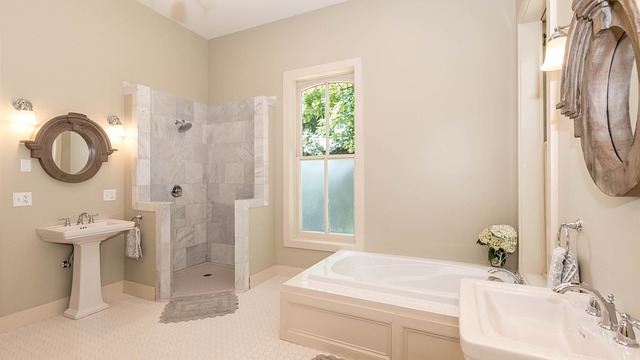Looking to create a healthier and more sustainable home environment? A bathroom remodel for eco-friendly living is an excellent starting point. This blog post explores how sustainable bathroom design, particularly through the use of VOC-free paints and finishes, can significantly improve indoor air quality, reduce environmental impact, and enhance your overall well-being. We’ll guide you through the process, from understanding the impact of VOCs to discovering eco-friendly paint options, water-saving fixtures, and recycled tile ideas. Get ready to transform your bathroom into a breathable sanctuary with our tips for a green bathroom renovation.
# Blog Post Outline: Bathroom Remodel for Eco-Friendly Living: Breathable Spaces with Sustainable Design
1. The Impact of VOCs on Indoor Air Quality
– Define Volatile Organic Compounds (VOCs) and their sources in paints, finishes, and building materials.
Volatile Organic Compounds (VOCs) are a group of chemicals that easily evaporate at room temperature, emitting harmful gases into the air. These compounds are commonly found in various products we use daily, including paints, finishes, and building materials. In the context of home renovations, particularly a bathroom remodel for eco-friendly living, understanding VOCs is crucial for creating a sustainable and healthy space. Many conventional paints and finishes release VOCs, which can contribute to indoor air pollution, especially in enclosed areas like bathrooms.
When considering a green bathroom renovation, homeowners can opt for VOC-free alternatives. For instance, using recycled or natural materials, such as bamboo or recycled tile ideas, reduces the demand for products emitting these compounds. Additionally, choosing water-saving fixtures and low-flow toilets not only benefits the environment but also minimizes the use of toxic chemicals often found in traditional plumbing materials. LED lighting for bathrooms is another sustainable option, as it reduces energy consumption without compromising quality. By making informed choices during a sustainable bathroom design project, homeowners can contribute to better air quality and create a more eco-friendly living space.
– Explain how VOCs can contribute to poor indoor air quality, health issues, and environmental concerns.
– Highlight the growing demand for healthier alternatives, especially in residential spaces like bathrooms.
In recent years, there’s been a noticeable shift in consumer preferences towards more sustainable and healthier living options, particularly within intimate spaces like bathrooms. This growing demand for eco-friendly alternatives is driven by an increasing awareness of indoor air pollution and its impact on well-being—a concern that resonates deeply with homeowners looking to renovate their bathrooms. As such, the market is witnessing a surge in popularity for VOC-free (Volatile Organic Compound) paints and finishes, which offer not just improved air quality but also contribute to a greener lifestyle.
When considering a bathroom remodel for eco-friendly living, every element from fixtures to materials plays a role. For instance, water-saving fixtures like low-flow toilets and efficient showerheads not only reduce utility bills but also minimize environmental impact. Recycled tile ideas are another sustainable option gaining traction, while LED lighting for bathrooms provides energy efficiency without compromising on aesthetics. These choices align with the broader trend of sustainable bathroom design, ensuring that personal spaces contribute positively to both individual health and global eco-conscious efforts.
In the pursuit of eco-friendly living, a sustainable bathroom remodel goes beyond energy-efficient fixtures and water-saving technologies. By selecting VOC-free paints and finishes, homeowners can significantly improve indoor air quality, addressing health concerns associated with volatile organic compounds (VOCs). This small change in material choice contributes to a greener, healthier home environment, aligning perfectly with the growing trend of sustainable bathroom design. Incorporating water-saving fixtures, eco-friendly materials like recycled tile, low-flow toilets, and LED lighting further enhances the eco-conscious renovation, ensuring a breathably fresh and aesthetically pleasing space.
